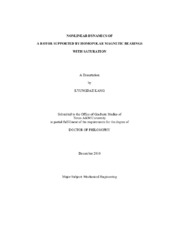| dc.contributor.advisor | Palazzolo, Alan B. | |
| dc.creator | Kang, Kyungdae | |
| dc.date.accessioned | 2011-02-22T22:24:41Z | |
| dc.date.accessioned | 2011-02-22T23:50:08Z | |
| dc.date.available | 2011-02-22T22:24:41Z | |
| dc.date.available | 2011-02-22T23:50:08Z | |
| dc.date.created | 2010-12 | |
| dc.date.issued | 2011-02-22 | |
| dc.date.submitted | December 2010 | |
| dc.identifier.uri | https://hdl.handle.net/1969.1/ETD-TAMU-2010-12-8902 | |
| dc.description.abstract | An objective in the design of high performance machinery is to minimize weight
so magnetic bearings are often designed to operate slightly lower than the magnetic
material saturation. Further weight reduction in the bearings requires operation in the
nonlinear portion of the B-H curve. This necessitates a more sophisticated analysis at the
bearing and rotordynamic system levels during the design stage. This dissertation
addresses this problem in a unique manner by developing a fully nonlinear homopolar
magnetic bearing model.
The nonlinear dynamics of permanent magnet-biased homopolar magnetic
bearing (PMB HoMB) system with 2-dof rigid and 4-dof flexible rotor is analyzed. The
dynamic behavior of the rotor-bearing system is examined in the feedback control loop
that includes low pass filter effects.
An analytical magnetization curve model is proposed to predict the nonlinear
magnetic force under the influence of the magnetic flux saturation more accurately. The
modified Langmuir method with the novel correction terms for the weak flux region is used to curve-fit the experimental magnetization data of Hiperco 50. A new curve fit
model of the B-H curve is shown to have significantly better agreement with the
measured counterpart than conventional piecewise linear and other models. PMB HoMB
characteristics with flux saturation, such as forces depending on the rotor position and
bearing stiffness, are compared with these other models.
Frequency response curve, bifurcation diagram, Poincare plot, and orbit plot are
utilized to demonstrate the effects of the nonlinearities included in the 2-dof rotorbearing
system.
Due to heavy static loads applied to the rotor, it operates within the magnetic flux
saturation region at the bearing clearance. The voltage saturation in the power amplifier
of the magnetic bearing introduces lag in the control loop and the response of the heavily
loaded 4-dof rotor-bearing system shows that limit cycle stability can be achieved due to
the magnetic flux saturation or current saturation in the amplifier; otherwise the system
would experience a destructive instability. These simulation results provide the first
explanation of this commonly observed limit cycle which is referred to as ‘virtual
catcher bearings’. | en |
| dc.format.mimetype | application/pdf | |
| dc.language.iso | en_US | |
| dc.subject | Nonlinear dynamics | en |
| dc.subject | Homopolar magnetic bearings | en |
| dc.subject | Saturation | en |
| dc.subject | Limit cycle | en |
| dc.title | Nonlinear Dynamics of a Rotor Supported by Homopolar Magnetic Bearings with Saturation | en |
| dc.type | Book | en |
| dc.type | Thesis | en |
| thesis.degree.department | Mechanical Engineering | en |
| thesis.degree.discipline | Mechanical Engineering | en |
| thesis.degree.grantor | Texas A&M University | en |
| thesis.degree.name | Doctor of Philosophy | en |
| thesis.degree.level | Doctoral | en |
| dc.contributor.committeeMember | Swaroop, Darbha | |
| dc.contributor.committeeMember | Langari, Reza | |
| dc.contributor.committeeMember | Strganac, Thomas W. | |
| dc.type.genre | Electronic Dissertation | en |
| dc.type.material | text | en |


